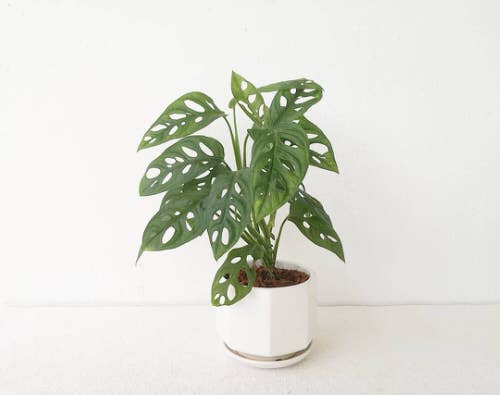With unique foliage, the Swiss Cheese Plant can add a tropical vibe to any room! Learn everything about Monstera Adansonii Care!

The Swiss Cheese plant might have a quirky name but remains one of the most spectacular plants. With ample green perforated leaves, it will make for a fantastic addition to your indoor garden. Let’s have a look at the Monstera Adansonii Care.
Have a look at the best types of Monstera you can grow here
Propagating Monstera Adansonii in Soil
Growing Swiss Cheese Plant in the soil is a pretty straightforward process.
- Just take a 4-6 inches long cutting having nodes and let it heal for some time.
- Dip the ends in honey and plant in a pot filled with a seed starter mix.
- Water well, cover the pot with a plastic bag, and keep it where it can get bright, indirect light.
- The cuttings will form roots in 2-3 weeks.
How To Grow Swiss Cheese Plant in Water
The best way to propagate the Swiss cheese plant is with cuttings in both soil and water.
- Using a sharp knife or shears, take 2-4 cuttings from a healthy plant. Make sure the cuttings have 1-2 leaves with nodes.
- Let the cuttings heal for 10-15 mins.
- Take a clean vase, fill it with nonchlorinated water, and dip the cuttings in it. You can also apply honey at the cutting’s end.
- Change the water every 3-5 days, and you will see the cuttings form roots in 2-3 weeks.
- You can either continue to grow the plant in water or transfer it into a pot filled with a quality potting mix.
We have a detailed article on propagating monstera in the water here
Monstera Adansonii Growing Requirements

Location
As it is a tropical plant, it thrives best in warm temperatures with bright, indirect light. Place it near an east-facing window where it will get some mild morning sun and bright light for the rest of the day. Avoid keeping the plant in harsh sunlight.
Soil
For the best growth, go for good quality potting mix. The plant does best in the pH range of 5.5-7.0. We also have a detailed article on how to make an awesome potting mix for plants at home here.
Water
Always keep the soil well-watered so that the plant is constantly moist. However, this doesn’t mean that you drench the soil wet. Keep a close eye on the topsoil and the moment it feels dry to the touch, water the plant.
Temperature and Humidity
The plant does best in the temperature range of 60-75 (15-25 C). For the best growth, make sure that you are maintaining the right humidity levels. Misting the foliage is one way to do it.
You can also keep the pot on a tray filled with pebbles and water. Getting a humidifier is also a good idea.
Monstera Adansonii Care

Fertilization
You don’t have to fertilize the plant for close to the first growing season if you have used a good-quality potting mix. After that, use a balanced liquid fertilizer diluted half to its strength once every 4-6 weeks.
Pruning
Being a climber, keeping it pruned will make sure it stays in the shape you want it. Also, snip away the damaged leaves and stems from time to time. Spring or autumn is the best time to give it a major trim.
Pests and Diseases
These plants are susceptible to spider mites, aphids, and scales. Do a regular check-up on the leaves and stems. Use neem oil or insecticidal soap to get rid of them.
Monstera Adansonii Toxicity
The plant can be mildly toxic if ingested in large quantities, due to the calcium oxalate crystals. So, it is a good idea to keep it away from your pets and small children.


